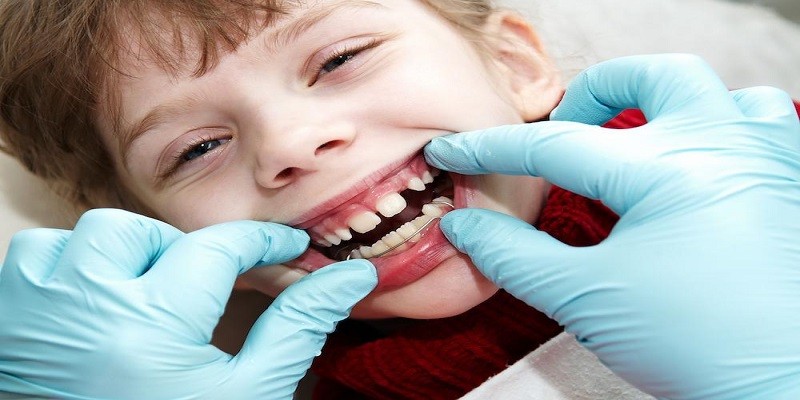Last Updated on January 15, 2025
Children should see an orthodontist between the ages of 7 and 9 to assess their orthodontic needs and address any potential issues at an early stage. During this time, the orthodontist can evaluate the child’s jaw growth and tooth development, and if necessary, recommend early orthodontic treatment to prevent or correct any dental problems.
This proactive approach can lead to better long-term oral health and result in shorter and less complicated orthodontic treatment later on. It is important for parents to bring their child to an orthodontist at an appropriate age to ensure timely intervention and optimal outcomes for their dental health.
Signs That Indicate Your Child Needs Orthodontic Treatment
Wondering when your child should see an orthodontist? Look out for signs like irregular bite, crowded or crooked teeth, mouth breathing, or difficulty in chewing and speaking. These indicators suggest that it’s time to seek orthodontic treatment for your child’s dental health and well-being.
Crooked Or Crowded Teeth
One of the most obvious signs that your child may need orthodontic treatment is if they have crooked or crowded teeth. When the permanent teeth start coming in, they should align well with each other and create an even bite. However, if your child’s teeth appear misaligned or overlapping, it’s important to consult with an orthodontist. Crooked or crowded teeth can not only affect the aesthetics of your child’s smile but can also lead to various oral health issues in the long run.
Difficulty Biting Or Chewing
Another sign that indicates your child needs orthodontic treatment is if they experience difficulty when biting or chewing. If your child frequently complains about discomfort or pain while eating, it could be due to a misaligned bite. A misaligned bite can make it challenging for your child to properly chew their food, which may lead to digestive problems and poor nutrition. It’s best to address this issue early on to prevent further complications.
Thumb Sucking Or Pacifier Habits
Thumb sucking and pacifier habits are common in younger children, but if these habits persist beyond the age of 5-6 years old, they can contribute to orthodontic problems. Prolonged thumb sucking or pacifier use can cause the teeth to shift out of alignment and affect the development of the jaw. If you notice that your child continues to engage in these habits, it’s advisable to consult with an orthodontist who can provide guidance and appropriate treatment options.
Early Or Late Loss Of Baby Teeth
The timing of your child’s baby tooth loss can also be an indication that orthodontic treatment may be necessary. If your child’s baby teeth are falling out significantly earlier or later than their peers, it could signal potential orthodontic issues. Early loss of baby teeth may result in inadequate spacing for the permanent teeth to come in, while late loss can cause the permanent teeth to grow in the wrong positions. Seeking early professional evaluation can help address any concerns and ensure your child’s dental development progresses smoothly.
The Benefits Of Early Orthodontic Intervention
Early orthodontic intervention offers several important benefits for children’s oral health, facial appearance, and overall well-being. By taking proactive measures to address dental issues at an early age, parents can help their children avoid future dental problems and improve their confidence. Let’s explore the key benefits of early orthodontic intervention:
Improved Oral Health
One of the primary benefits of early orthodontic intervention is the improvement it brings to a child’s oral health. By correcting issues such as misaligned teeth, overcrowding, or improper bites, orthodontic treatment helps promote good oral hygiene habits and reduces the risk of tooth decay, cavities, and gum disease. Straightening teeth and aligning the jaws also make brushing and flossing more effective, ensuring the child can maintain healthy teeth and gums.
Enhanced Facial Appearance
Orthodontic treatment not only improves oral health but also enhances a child’s facial appearance. Crooked or misaligned teeth can affect the symmetry and balance of the face, causing self-consciousness and potentially leading to low self-esteem in the long run. By correcting these issues early on, orthodontic intervention can help children achieve a more harmonious and aesthetically pleasing smile, boosting their self-confidence and overall facial attractiveness.
Prevention Of Future Dental Problems
Addressing orthodontic issues at an early age can help prevent future dental problems. By identifying and treating any underlying problems, orthodontists can minimize the risk of developing more severe issues later in life. Untreated orthodontic problems can lead to difficulties with eating, speaking, and even breathing. Early intervention not only reduces the need for complex and invasive treatments in the future but also ensures that a child’s dental health remains optimal throughout their lives.
Boost In Self-confidence
Having a healthy and attractive smile plays a crucial role in a child’s self-confidence. When children have misaligned or crooked teeth, they may feel self-conscious about their appearance and hesitate to smile or engage in social interactions. Early orthodontic intervention not only improves the alignment and appearance of teeth but also helps children develop a positive self-image. By providing the opportunity for a beautiful smile from an early age, orthodontic treatment boosts self-confidence and allows children to feel more comfortable and confident in their everyday lives.
Factors To Consider When Choosing An Orthodontist For Your Child
Choosing the right orthodontist for your child is crucial. Factors to consider include their experience, expertise, and reputation, as well as their ability to communicate and make your child comfortable during the treatment process.
When it comes to your child’s dental health, choosing the right orthodontist is crucial. Not only will they be responsible for straightening your child’s teeth and improving their smile, but they will also play a significant role in their overall oral health. With so many options to choose from, it is important to consider a few key factors when making your decision. Here are some essential factors to keep in mind when selecting an orthodontist for your child.
Experience And Credentials
One of the most important factors to consider when choosing an orthodontist for your child is their experience and credentials. Look for an orthodontist who has a wealth of experience and has treated a variety of orthodontic issues similar to your child’s. A highly experienced orthodontist will have the expertise to develop an individualized treatment plan for your child and handle any complications that may arise during the treatment process.
Additionally, take the time to research the orthodontist’s credentials. Look for board certification, which indicates that they have undergone additional training and testing in the field of orthodontics. This certification ensures that the orthodontist has met the highest standards of professional competence. An orthodontist with proper credentials will provide you with peace of mind, knowing that your child is in capable hands.
Treatment Options Offered
Another crucial factor to consider when selecting an orthodontist for your child is the range of treatment options they offer. Each child is unique, and their orthodontic needs may vary. Look for an orthodontist who offers a variety of treatment options that can address your child’s specific needs.
Some common orthodontic treatment options include traditional braces, clear aligners, and retainers. Traditional braces are the most common and effective way to straighten teeth, whereas clear aligners offer a more discreet alternative. An orthodontist who provides a range of options will be able to recommend the best treatment plan for your child, taking into account their age, oral health, and personal preferences.
Office Environment And Facilities
The office environment and facilities play a crucial role in your child’s overall orthodontic experience. Look for an orthodontist who has a welcoming and child-friendly office environment. A bright and inviting waiting area, with toys and games, can help ease any anxiety your child may feel about visiting the orthodontist.
In addition to the office environment, consider the facilities and technology available at the orthodontist’s clinic. Modern orthodontic practices utilize advanced technology and equipment, which can enhance the accuracy, efficiency, and comfort of treatments. An orthodontist who invests in state-of-the-art technology demonstrates a commitment to providing the best possible care for their patients.
Insurance Coverage And Payment Plans
When considering an orthodontist for your child, it is important to take into account insurance coverage and payment plans. Orthodontic treatment can be a significant financial investment, so it is essential to understand the costs involved and the options available to you.
First, check whether the orthodontist accepts your insurance plan. Inquire about the extent of coverage for orthodontic treatments and any limitations or exclusions that may apply. If your insurance does not cover orthodontic treatment, ask the orthodontist about their payment plans. Many orthodontists offer flexible payment options, such as monthly installments, to make treatment more affordable for families.
When choosing an orthodontist for your child, consider their experience and credentials, the range of treatment options they offer, the office environment and facilities, as well as insurance coverage and payment plans. By taking these factors into account, you can ensure that your child receives the best possible orthodontic care and achieves a healthy and beautiful smile.

Credit: www.blueridgeorthodontics.com
Frequently Asked Questions For When Should My Child See An Orthodontist?
At What Age Should My Child First See An Orthodontist?
It is recommended that children have their first visit to an orthodontist by the age of 7 to detect any potential orthodontic issues early on.
What Are The Common Signs That My Child May Need Orthodontic Treatment?
Some common signs include crowded or crooked teeth, difficulty biting or chewing, early loss of baby teeth, or an abnormal bite.
How Can Orthodontic Treatment Benefit My Child?
Orthodontic treatment can straighten teeth, improve oral health and function, enhance self-esteem, and create a beautiful smile that lasts a lifetime.
Will My Child Experience Any Discomfort During Orthodontic Treatment?
Orthodontic treatment may cause some temporary discomfort, especially after adjustments, but any discomfort can be managed with over-the-counter pain relievers.
Can My Child Still Participate In Sports And Activities While Wearing Braces?
Yes, your child can still participate in sports and activities while wearing braces. We recommend using a mouthguard to protect the braces and teeth.
How Long Will My Child Need To Wear Braces Or Other Orthodontic Appliances?
The duration of orthodontic treatment varies depending on the individual case, but typically ranges from 1 to 3 years. Regular check-ups will be scheduled to monitor progress.
Conclusion
To ensure your child’s dental health, it is vital to consider when they should see an orthodontist. Early evaluation can prevent potential issues, allowing for timely treatment and better results in the long run. By addressing misaligned teeth or jaw problems at an early age, you can contribute to your child’s overall oral health and self-confidence.
Trust your instincts and consult a qualified orthodontist to give your child a beautiful smile that lasts a lifetime.

